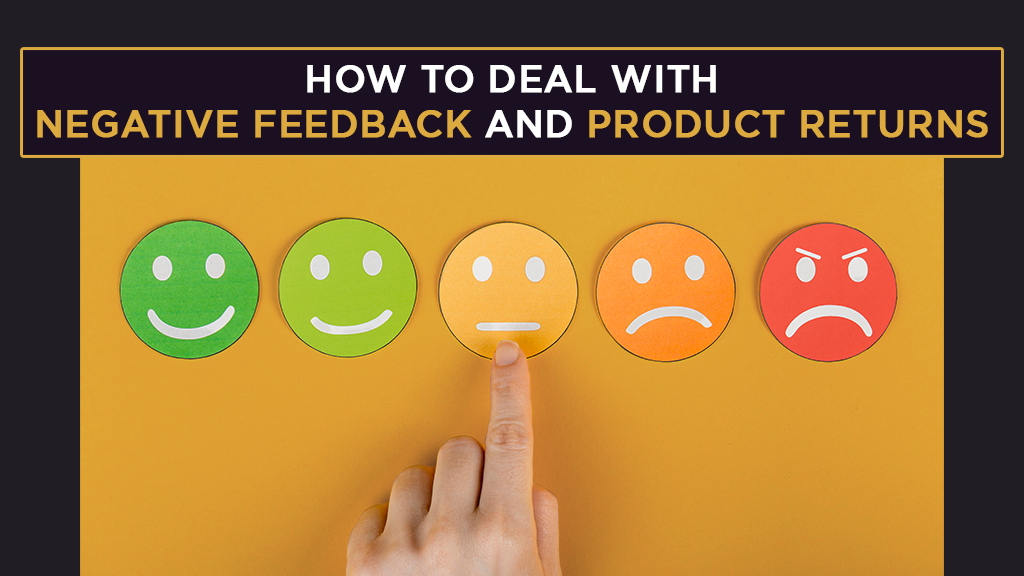
Negative feedback is never fun. You spent hours upon hours painstakingly refining your product — of course, it doesn’t feel good to see it torn to shreds.
But in business, you can’t simply “ignore the haters.” Like it or not, dealing with negative customer feedback on Amazon, eBay, and social media is part of life as a product creator. In fact, it can be a major opportunity to listen to customers, improve your product, and elevate your brand.
Today, let’s talk about the impact of negative feedback and ways to improve your customer satisfaction strategy.
- Marketing strategies to address negative public feedback
- How to deal with bad customer feedback online
- Handling customer complaints effectively
- Handling returned products from customers
- Strategies for improving customer satisfaction
Contents
- Understanding negative feedback
- Handling negative feedback
- Marketing Strategies for Addressing Public Feedback
- Strategies for customer satisfaction
- Embracing product returns
- Preventing negative feedback and returns
- Final thoughts
- How to deal with negative feedback and product returns: Frequently asked questions
Understanding negative feedback
First, let’s clarify what negative feedback is and it is not. Kickstarter and Indiegogo both have clear community guidelines on what types of comments they will and will not tolerate.
The following types of comments do not lend themselves to constructive dialogue between you and your customers. When we talk about negative feedback, we are not referring to:
- Harassment
- Hate speech or bigotry
- Cyberbullying
- Spam
- Doxxing
On the other hand, Kickstarter does encourage users to:
- Engage in lively, respectful discussion about the project.
- Give constructive feedback and ask questions.
- As a creator, be transparent about how your creation is going and keep everyone informed.
Crowdfunding backers are some of the most passionate, engaged people in the consumer market. That’s what we love about crowdfunding. Your campaign page, VIP group, and social media should be full of lively discussion about your product.
But when things go wrong, the conversation gets a little trickier. When backers are frustrated with shipping delays, product bugs, or manufacturing defects, they may vent and complain on:
- Your campaign page
- Post-campaign surveys
- Social media feed
- DMs and emails
- Reviews on e-commerce sites
- Reviews on third-party forums
- Customer service chat boxes
Don’t underestimate the impact of negative feedback. When complaints go unanswered, they erode your reputation and brand image. To reestablish trust and credibility, it’s important to learn how to deal with negative customer feedback.
Handling negative feedback
We can’t talk about customer service without mentioning Zappos. Zappos started as a humble online shoe retailer in 1999. It’s now a global, billion-dollar company under Amazon, and it’s made a name for itself in customer service.
From free shipping to 365-return policies to 24-hour customer service, Zappos’s customer service is world-class. They’ve mastered the art of turning negatives into positives.
Take Jay, for example. Jay ordered shoes from Zappos to wear to his best friend’s wedding. He picked 3-day shipping, which should’ve been plenty of time — except his package ended up at the wrong address. Jay had no shoes, the wedding was in 48-hours, and he was the best man!
Jay called customer service and explained his dilemma. Zappos immediately over-nighted him a new pair and issued a complete refund.
Despite the initial hiccup, Jay made it to the wedding, rocking his new shoes. He had this to say about the experience: “Free shoes. Unbelievable. Zappos has earned a customer for life.”
We can take away these lessons from Jay’s story. When you receive negative feedback:
- Respond promptly. When things go wrong, customers are anxious, frustrated, and confused. Don’t let them stew in their negative emotions. Plus, if the issue is time-sensitive, you want to catch it before it’s too late.
- Show empathy. Take time to understand the customer’s experience and feel their struggle.
- Provide tangible solutions. A “sorry” by itself is not enough. Take real measures to improve the customer’s situation.
Marketing Strategies for Addressing Public Feedback
Public feedback is nerve-wracking. Every 1-star review and social media comment is out there for the world to see. It can feel like your brand’s reputation is at the mercy of one viral Tweet.
But public feedback invites equally public responses. This can be an amazing opportunity to make lemons into lemonade. Here are three companies that turned negative feedback into brilliant marketing strategies.
Ryanair Owned Their Weaknesses
Ryanair is a popular budget airline in Europe. But there are trade-offs for being so cheap.
A customer Tweeted a picture of their window seat, complaining about the lack of windows. This was Ryanair’s response.

No, Ryanair didn’t get hacked. Yes, this is a real Tweet.
They essentially said, “You’re right. We have crappy seats. But we have cheap flights, and that’s why customers choose us.”
By owning their weakness, they actually highlighted their biggest differentiator, cost.
When you have nothing to hide, your customers have no reason to distrust you. And when you can laugh at yourself, no one can use your weaknesses against you.
Oatley Polarized and Reframed
Oatley released this shocking ad: “This tastes like sh*t! Blah!” This was a real comment from a real person who tried and hated their oatmilk.

Sometimes, a bad review comes from someone who simply isn’t a fit for your product.
Your product isn’t for everyone. That’s okay. In Oatley’s case, people who don’t like the taste of oats simply won’t like a drink that tastes like oats.
Oatley polarized their audience: “If you don’t like the taste of our oatmilks, you don’t have to drink them.”
And then they reframed: “There are a growing number of people who find oatmilk delicious.”
Don’t be afraid to send the message: “You’re in or you’re out.”
When you polarize and reframe, you tell customers, “If you’re out, we won’t take it personally. But if you’re in, we have a great product for you.”
Johnson & Johnson Took Serious Action
Early in the morning of September 29, 1982, 12-year-old Mary Kellermen woke up with a sore throat and runny nose. Her parents gave her one extra-strength Tylenol before sending her off to school. Hours later, she was in the hospital. The next day, she was dead.
A string of deaths quickly followed — Adam, Stanley, and Theresa Janus; Mary McFarland; Paula Prince; Mary Reiner. And all of them had consumed Tylenol shortly before they died.
Investigators made a terrifying discovery — these Tylenol capsules had been intercepted, filled with cyanide, and circulated back into stores. Media was immediately on the scene. Reporters closed in. Panic spread. If negative publicity got out of control, Johnson & Johnson stood to lose hundreds of millions of customers.
So what did they do? Johnson & Johnson recalled all 31 million Tylenol bottles in the United States. They took full responsibility in the press. They issued public warnings to immediately stop using Tylenol.
And they relaunched Tylenol with new tamper-proof packaging, now the industry standard for all over-the-counter medications.
Johnson & Johnson suffered 1.9 billion in losses but saved their brand image. Stocks recovered two months later. The company completely regained its market share.
Let’s hope your brand never faces a situation remotely similar to this one. But the same principles apply. Put your customers’ safety first. Be transparent. And if things go wrong, take serious action to remedy and improve your product.
Strategies for customer satisfaction
Customer feedback management is a continuous loop. In his book The Lean Startup, Eric Ries calls it the Build, Measure, Learn loop.

Successful entrepreneurs know that business is a never-ending set of experiments. A customer satisfaction feedback loop looks like this:
- Build an experiment. Every product release and product improvement is a hypothesis. You think you know what customers want. But your hypothesis needs to be proved or disproved.
- Measure the data. Collect feedback from surveys, reviews, forums, and comments. Analyze product returns data. Invite customers to share suggestions and ideas.
- Learn from the data. Implement feedback. Innovate and improve.
And then, rinse and repeat. Keep testing, keep asking for feedback, and keep innovating. The more you ask for feedback, the more you grow and elevate your brand.
Embracing product returns
Even with the best product imaginable, you can’t fully control product returns. What you can control is the customer experience. A clear, customer-friendly return policy will increase customer satisfaction, build trust and loyalty, and win repeat business.
Here are our tips for how to handle product returns:
- Clearly communicate your return policy. Make it easy for customers to read the return policy on your website. Ensure that customers are aware of the conditions and procedures for returns.
- Provide multiple return options. Offer various methods for returns, such as mail-in returns or third-party drop-off locations. Give customers the flexibility to pick the most convenient option for them.
- Make returns hassle-free. Do customers need to print a return label? Pay their own shipping fees? The more hoops you make them jump through, the less likely they’ll buy again.
- Quick refunds or exchanges. Process refunds and exchanges promptly. If customers are waiting weeks for their money to return to their credit card, they’ll be even more frustrated and dissatisfied.
- Track and analyze return data. Keep records of returned products. Most major e-commerce platforms like Amazon and eBay will track reasons for returns. Analyze the data for patterns. Are there any recurring issues with product quality? These insights will inform your product development strategy.
Embrace the fact that product returns will happen. Your return policy is a great opportunity to improve your customer satisfaction strategy. A fair, flexible, and customer-centric policy will win you business over your competitors.
Preventing negative feedback and returns
It sounds counterintuitive, but the best way to prevent negative feedback is to ask for feedback. Negative feedback happens when results don’t match customer expectations. So work to understand what customers expect and want.
Invite backers to be collaborators in your project. Ask for their opinions and suggestions. What do they want and need? What problems and pain points are most frustrating? Which features are must-haves and which are nice-to-haves?
Use customer feedback to refine your product and customer experience. When customers feel listened to, they are much less likely to write an angry review or return their purchase.
For example, we invited backers to contribute ideas for Author Clock, a digital clock that tells time through literary quotes. We opened a submission page where backers could submit quotes they wanted to see in the final product. We built a thriving community of book lovers, kept backers engaged, and best of all, delivered a product customers love.
Author Clock raised $2,161,273 on Kickstarter and Indiegogo.

For Simon Lasnier’s Midronome, a synchronization device that raised $177,664 on Kickstarter, we created a forum where backers could ask questions, report bugs, and request features. When users encountered issues, Simon personally apologized to each poster and offered technical support. Simon’s prompt, helpful responses built trust and made customers less inclined to return their Midronome.
Final thoughts
Negative feedback is unavoidable. But the way you respond to feedback speaks volumes. Think about the message you’re sending: Do you take responsibility for mistakes? Can you laugh at yourself? How do you treat your customers? Are you innovating and growing as a company?
Use these insights from today to improve your customer satisfaction strategy:
- How to deal with negative feedback on eBay, Amazon, and social media
- Incorporating negative feedback into your marketing strategy
- Strategies to improve customer satisfaction
- How to reduce product return and learn from product returns data
How to deal with negative feedback and product returns: Frequently asked questions
What should I do when I receive negative feedback from a customer?
It’s an age-old cliche — actions speak louder than words. Whether it’s a refund or exchange, technical support, vouchers, or product improvements, think about what solutions can best address the customer’s issues.
What are some effective strategies for managing online reviews and ratings when they’re negative?
When you receive a negative rating or review:
-
- Respond promptly. Don’t let a review or comment sit for days unanswered.
- Show empathy. Know that 1-star reviews are typically emotional. Acknowledge their frustration.
- Be transparent. Don’t be afraid to over-share. Customers don’t always know what happens behind the scenes. Providing extra context tells customers you have nothing to hide.
How can I turn negative feedback into an opportunity for improvement and growth?
Feedback is an incredible opportunity for improvement and growth. Analyze data from surveys, comments, reviews, and returns data. Look for patterns and recurring issues. Create a continuous feedback loop between you and your customers.
How can I create a customer-friendly return policy?
A customer-friendly return policy should be reasonable, fair, and convenient. Make sure you:
- Clearly communicate your return policy.
- Provide multiple return options for additional convenience.
- Make returns hassle-free.
- Process refunds and exchanges quickly and efficiently.
What are common mistakes to avoid?
Here are some common mistakes businesses make in their customer satisfaction strategy:
- Not actively listening. Don’t brush off complaints. Give customers the chance to share their experiences.
- Over-promising. Be realistic about manufacturing and delivery timelines. In your FAQs, be transparent about what your product can and can’t do. If you over-promise in your crowdfunding campaign, you’re going to have disappointed, frustrated customers.
- Keeping customers in the dark. In crowdfunding, bad news is better than no news. If there’s a shipping delay, update customers as soon as possible. If you’re noticing defects and bugs, make customers aware.
Despite this, mistakes are bound to happen. We believe in having a testing mindset; there’s huge merit in learning by failing. But if there’s one thing more effective than learning from your own mistakes, it’s learning from the mistakes of others.
At LaunchBoom, we’ve worked with thousands of product creators from 40 different countries and we’ve raised over $100M in crowdfunding revenue. Over the years, we’ve learned a lot about launching products and creating long-term customer satisfaction.
We compiled a ton of insights into our book Crowdfunded, which you can download for free here. Want further insights for your brand? Talk to an expert today.




